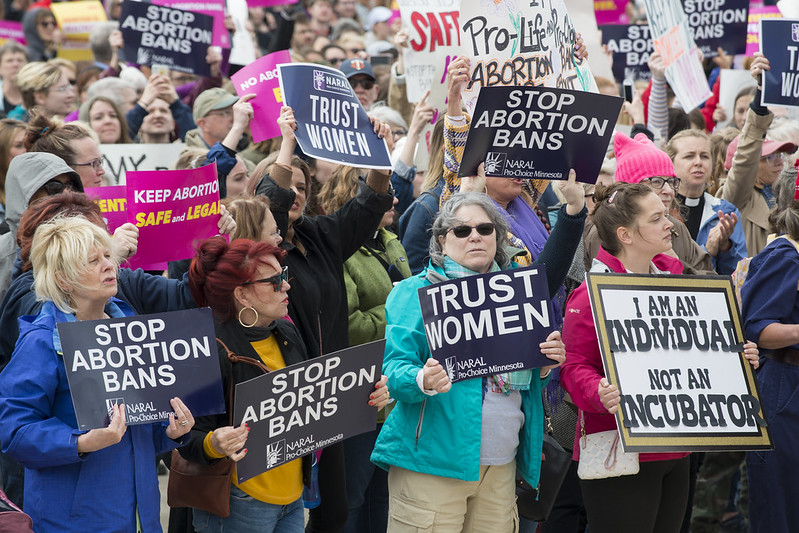Roe v. Wade has been a defining legal backdrop for women for almost 50 years.
But with Supreme Court Justices Neil Gorsuch and Brett Kavanaugh poised to weigh in on their first major abortion case this week in June Medical Services v. Russo, Roe’s future is grim.
This moment should come as no surprise to those who’ve been watching. But how did it come to this?

Roe v. Wade
To begin, Roe v. Wade wasn’t an opinion about women’s equality. Justice Blackmun’s 7-2 majority opinion was concerned with privacy—and even then, that right was never one that women enjoyed alone: It was shared with their doctors (“the attending physician, in consultation with his patient, is free to determine… [that] the patient’s pregnancy should be terminated”).
Moreover, from its inception, women’s privacy was balanced against the state’s interest in protecting women’s health and “potential life.” While Roe wasn’t expressly feminist, the right to abortion the Court recognized was a robust, fundamental right.
Roe left abortion free of regulation in the first trimester, permitting regulation in the second trimester only if it was reasonably related to maternal health. States could severely limit or proscribe abortion only post-viability.
Planned Parenthood v. Casey
That changed in 1993 with Planned Parenthood v. Casey, when a more polarized Supreme Court had its first real chance to reverse Roe. Instead of reversing, a divided Court cobbled together the votes to reaffirm what it characterized as Roe’s “basic holding.”
But it also abandoned the trimester framework and demoted the right to abortion to something less than fundamental. Casey left states free to regulate abortion at any point during pregnancy, provided those restrictions didn’t impose an “undue burden” on a woman’s right to abortion pre-viability. In other words, pre-viability restrictions were now presumptively valid unless they had the purpose or effect of placing a substantial obstacle in the path of a woman seeking an abortion.
Casey gave legitimacy to a flood of state abortion regulations in the name of women’s health and safety—usually framed as protection from abortion—along with women’s education, persuasion and fetal protection.
Whole Woman’s Health v. Hellerstedt
In 2016, the Court had yet another chance to gut Roe in Whole Woman’s Health v. Hellerstedt. This time—with Justice Scalia’s passing and the Republican Senate’s refusal to fill the open seat during President Obama’s second term—the Court appeared equally divided. In a 5-3 opinion that greatly relieved abortion advocates, Justice Kennedy joined the Court’s four liberals to invalidate two provisions of a Texas law that threatened to close three quarters of its clinics. The Court appeared to put teeth into Casey’s undue burden standard, finding that the Texas law failed to protect women from anything while seriously impeding women’s access.
Whole Woman’s Health was also a narrow opinion, tethered to the facts that made that particular Texas law unconstitutional. The Court’s fact-heavy analysis left room for future litigation as to its reach.
Roe v. Wade: Death by a Thousand Cuts
It’s in this legal context that the right to abortion has eroded into a patchwork of restrictive state regulations, most of which have withstood legal challenge. States have passed more than 1200 abortion restrictions since Roe, with 516 enacted in the last 9 years alone. Under this matrix of state laws, 58 percent of American women of reproductive age live in states considered hostile to abortion rights; and 90 percent of U.S. counties lack a single abortion provider.
Roe has long been imperiled. But with President Trump’s two appointees on the Court, anti-abortion advocates finally have the Court they’ve dreamed of—and they have been working feverishly to make the most of it.
Anti-choice state legislators introduced 378 abortion restrictions in the first five months of 2019. Many of these laws were blatantly unconstitutional under current doctrine, designed to prompt a showdown with Roe before the sympathetic Court.
With a host of draconian abortion restrictions working their way through the lower Federal Courts, the Supreme Court agreed to hear June Medical Services v. Russo. It is a challenge to a Louisiana admitting privileges requirement that’s nearly identical to one of the Texas provisions found unconstitutional in Whole Woman’s Health. The Louisiana law, like its Texas counterpart, was designed to close clinics. If allowed to stand, it would leave one abortion provider in Louisiana.
Rather than pronouncing Roe dead, many analysts anticipate a 5-4 majority of the Court will exercise restraint—with Chief Justice Roberts as the conservative “swing.” In a nod to precedent and an effort to stave off backlash, the Court will likely leave Roe and Casey standing, at least in name. The Court will likely contort the facts to save the Louisiana law, distinguishing it from its Texas twin. It may weaken the “undue burden” standard such that it offers virtually no protection against even the harshest abortion regulations. Alternatively, the Court might deny the rights of providers to bring challenges against abortion laws, imposing a barrier to future abortion litigation.
The Future of Americans’ Right to an Abortion
Whatever its rationale, the Court has little to gain by pronouncing Roe dead ahead of the 2020 elections. Better to continue along the path of suffocating Roe to the point of irrelevance.
As the Court moves “incrementally,” it will nevertheless create a legal climate in which abortion rights are more profoundly and swiftly undermined. Conservative lawmakers will continue to pass a barrage of ever-more restrictive and unconstitutional laws. The Court may have its pick in landing its next blow to abortion—it could uphold a procedural ban, a reason ban or an ultrasound requirement, to name a few.
At the same time, lower federal courts, packed with Trump appointees, may feel emboldened to contort and even defy Supreme Court precedent to uphold more restrictive abortion laws. This trend will accelerate, particularly should the Supreme Court vindicate the 5th Circuit for ignoring Whole Woman’s Health when it decides June Medical Services. The Circuit Courts may well have the last word in several cases. This feedback loop will likely intensify as we lose what’s left of Roe.
Eventually, the stage may be set for a head-on collision at the Supreme Court with Roe. By that point, Roe may be so hollowed out that it will fall like a feather.
Justice Blackmun, writing separately in Casey, predicted this day would come almost 30 years ago:
“I fear for the darkness as four Justices anxiously await the single vote necessary to extinguish [Roe’s] light.”
They’ve got their fifth vote now.





